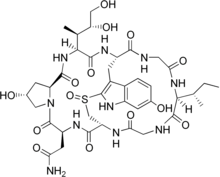




Cyclic peptides are polypeptide chains which contain a circular sequence of bonds.[1] This can be through a connection between the amino and carboxyl ends of the peptide, for example in cyclosporin; a connection between the amino end and a side chain, for example in bacitracin; the carboxyl end and a side chain, for example in colistin; or two side chains or more complicated arrangements, for example in alpha-amanitin. Many cyclic peptides have been discovered in nature and many others have been synthesized in the laboratory. Their length ranges from just two amino acid residues to hundreds. In nature they are frequently antimicrobial or toxic; in medicine they have various applications, for example as antibiotics and immunosuppressive agents.[2] Thin-Layer Chromatography (TLC) is a convenient method to detect cyclic peptides in crude extract from bio-mass.[3]
Cyclic peptides can be classified according to the types of bonds that comprise the ring.
Cyclic peptides in plants are synthesized via a two-step process; the translation of a linear peptide chain, and its subsequent formation into a cyclic structure through activities of a protease-like enzyme or other ways.[5][6][7]
Cyclic peptides tend to be extremely resistant to the process of digestion, making them of interest to scientists working on novel oral medications.[8]
Examples include:
{{cite journal}}: Cite journal requires |journal= (help)